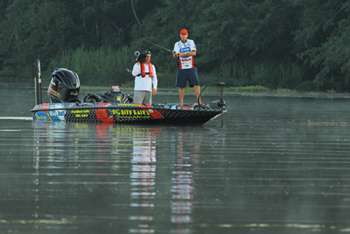
Less is more for Russ Lane when he fishes in late fall. Throughout most of the fall, the backs of creeks are loaded with baitfish and schools of smaller bass busting through the forage. But, as daylight hours shorten and the water temperature drops into the lower 60s and upper 50s, the large schools of shad leave, and the smaller bass follow the forage out toward the main lake.
"When that happens, I think the bigger fish move into those places and roam around on those flats on certain days, and on other days they get on isolated pieces of cover and feed on the few shad that are back there along with bream and crawfish," says Lane.
So, if you follow, he hopes to find less shad in the backs of the creeks in order to catch more big bass.
"I think it's more important for catching the bigger fish that the majority of the shad have left," he says. "It makes it a little bit easier for you to fool the fish, because there aren't as many shad left in the area."
The Alabama pro targets the backs of creeks with hard-bottom flats in 2 to 4 feet of water adjacent to the creek channels that have depths of 4 to 6 feet. His favorite lures for working the flats are a 1/2-ounce Spro Aruku Shad 75 lipless crankbait (in Nasty Shad or chrome/blue hues) and a 3/8- or 1/2-ounce Buckeye Lures Swim Jig tipped with a Big Bite Baits Fighting Frog.
His favorite color combinations for the jig-and-frog are a black-and-blue jig with a hematoma-hue frog or a green pumpkin jig with a tilapia-color trailer. The lipless crankbait performs best on cloudy days with a little wind that prompts bass to roam around on the shallow flat.
"I just get out on that flat and move around and maybe follow the creek channel a little bit," says Lane. "There is no telling where I might get bit."
He makes long casts with the crankbait, holds his rod tip high and reels fast to cover a lot of water. His retrieve speed is just quick enough to keep the lure off the bottom but not too fast to cause the lure to roll over.
"On those days that everyone dreads when it's bright with no wind and the fish don't seem to be active, you can get on the flat and find whatever the dominant cover is — whether it's isolated pieces of wood or bank grass or flat reeds — and the fish set up on that kind of cover," says Lane.
Then the Alabama pro relies on the jig-and-frog, which he casts past the cover and reels steadily while constantly bouncing his rod tip. The Fighting Frog excels for Lane during this presentation.
"It's a bulky bait that most people use for flipping matted grass, but on its back it has two appendages shaped like claws or frog legs that have a real distinct undulating action when I'm hopping it and reeling it fast," says Lane.
Deflecting the swim jig off the cover is the key to Lane's fast retrieve.
"I try to hit the piece of cover, and that's what triggers the strike," says Lane. After the jig hits the cover, Lane either stops his retrieve so the jig falls straight down or he quickly hops it away from the cover. In early autumn, the best action in the creeks is in the morning, but Lane notices the afternoons are best for his late fall pattern.
"Those fish will really get active in the last three to four hours of the day after the sun starts its descent," he says. The big fish pattern continues to produce for Lane until the water temperature dips into the mid to lower 50-degree range. Then the quality bass tend to follow the creek channel out to the deeper channel bends and eventually migrate to their winter sanctuaries on or near the main lake.





